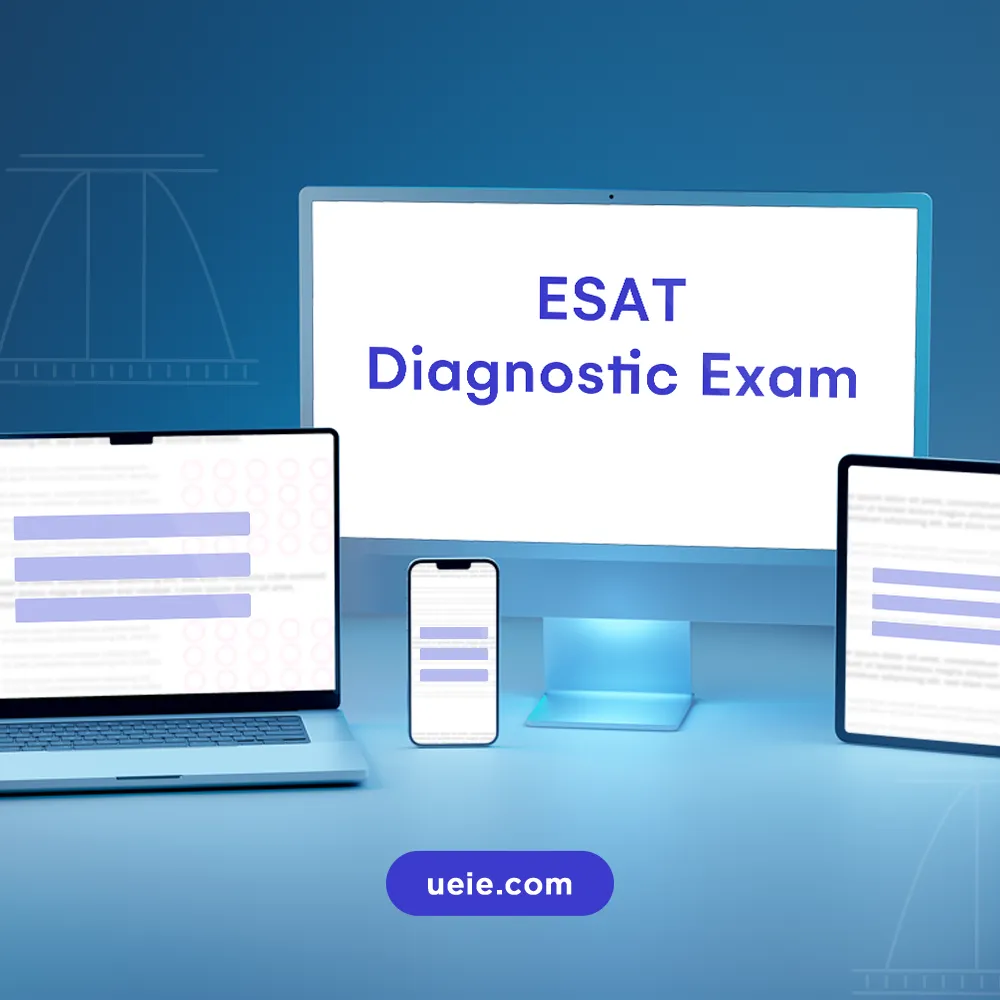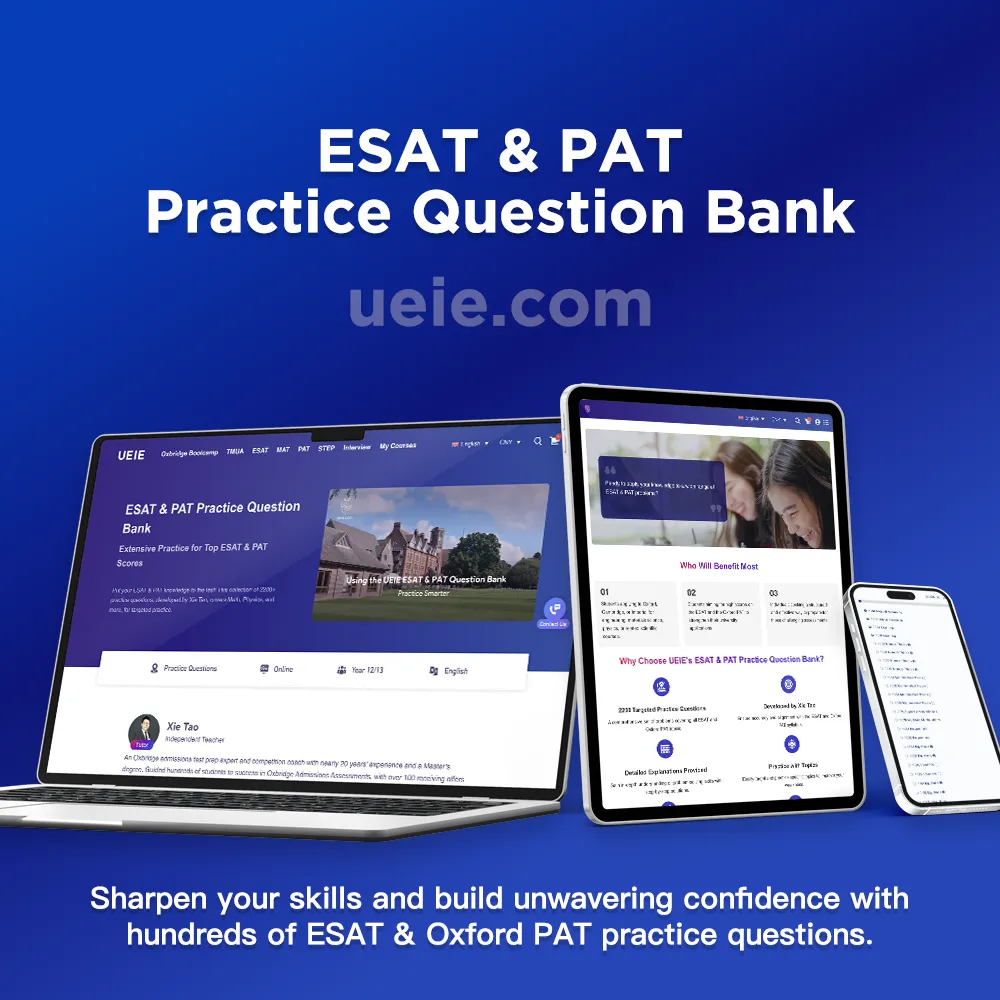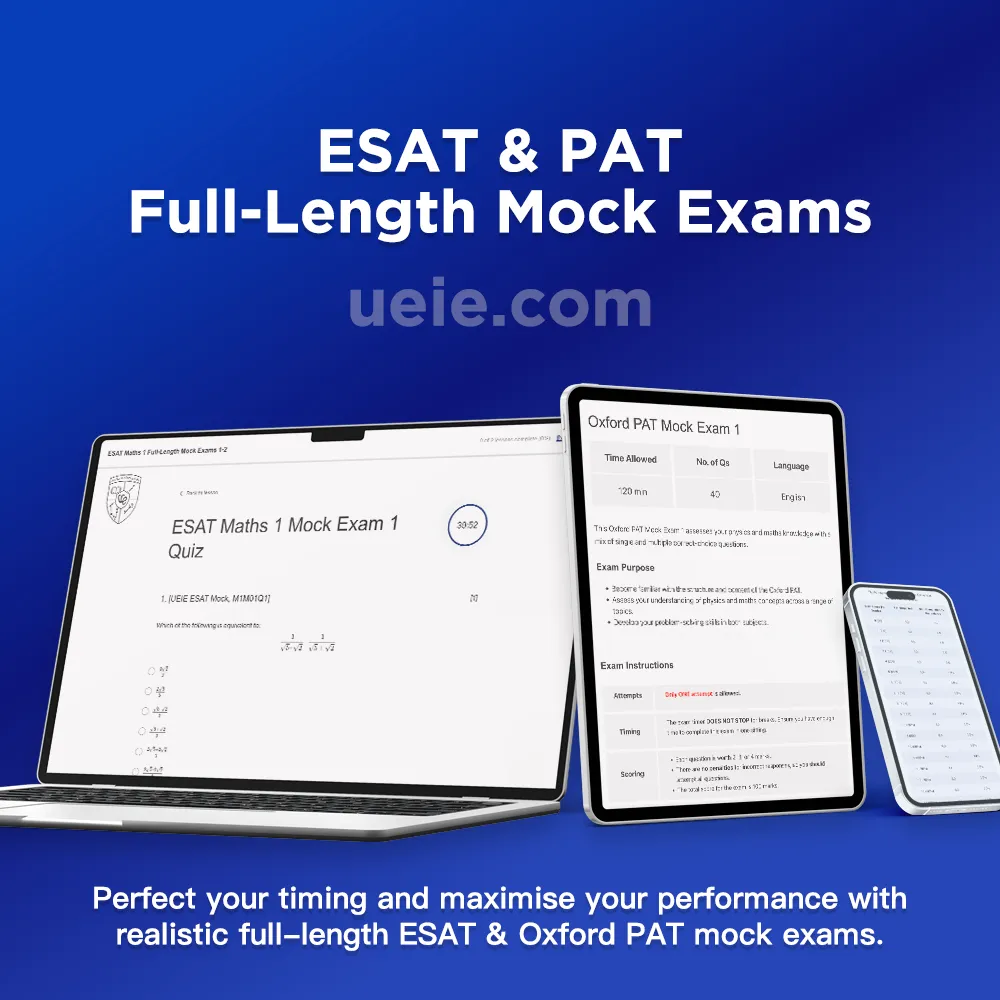
Independent Teacher

In preparing for the Engineering and Science Admissions Test (ESAT) – a relatively recent online assessment demanding exceptional speed and precision in the application of knowledge – many students may find themselves at a crossroads: How can one most effectively cultivate the integrated application of knowledge across diverse courses? What is the optimal approach to structuring one’s preparation for maximum efficacy? Furthermore, how does one best adapt to the intricacies of an online, computer-based test format?
This ESAT Preparation Guide distils my (Mr. Xie Tao’s) accumulated years of practical experience and considered insights from mentoring students through comparable written assessments and allied academic competitions. Its purpose is to furnish you with a systematic and highly effective framework of preparatory strategies and methodologies, designed to empower you to successfully navigate the challenges of the ESAT.
Prior to immersing yourself in the preparatory strategies detailed within this guide, it is unequivocally recommended that you first undertake a thorough review of the ESAT Comprehensive Guide. This will ensure a complete understanding of the most current developments, specific requirements, test format, and detailed scoring criteria.
To embark upon your ESAT preparation journey with clarity and purpose, it is paramount to first establish a precise understanding of your ultimate destination – your target outcome – and your current starting point – your existing capabilities. This foundational understanding is the very bedrock upon which all effective preparation strategies are constructed.
Before committing substantial time and effort to your preparation, it is imperative to ascertain the following critical details:
Given that the ESAT is a novel examination utilising a distinct online, non-calculator, multiple-choice format, the undertaking of a preliminary diagnostic assessment (a baseline evaluation) prior to commencing formal preparation is of particular importance. This will enable you to:
Selection of an Assessment Instrument

Free ESAT Diagnostic Exam
Replication of Authentic Conditions
Objective Scrutiny and Analysis
Having acquired an understanding of the requisite standards and your own initial standing, the subsequent stage involves the formulation of scientific and pragmatic preparation objectives.
ESAT preparation constitutes a rigorous examination of one’s knowledge, alacrity, technical skill, and mental fortitude. It is imperative that you:
A precise understanding of the specific knowledge prerequisites for each ESAT subject, effectively integrated with your individual educational history, represents the inaugural step towards an efficient and productive preparation regimen.
Irrespective of the curriculum system you are currently following, the critical imperative is to proactively and meticulously juxtapose your existing learning content with the official ESAT syllabus. This process will enable the identification of potential knowledge lacunae or areas of relative weakness, thereby facilitating the formulation of a targeted supplementary study plan. The ensuing table delineates the approximate correspondence between the principal ESAT elective modules and prevalent curriculum systems, accompanied by pertinent recommendations:
ESAT Module
A-Level
AP
IB
UK National Curriculum (England)
Mathematics 2
Strictly circumscribed by the A-Level Mathematics syllabus.
Calculus AB/BC addresses calculus; supplementary revision of non-calculus elements from Pre-Calculus, such as algebra, functions, trigonometry, and coordinate geometry, is requisite.
DP Mathematics SL (Analysis and Approaches / Applications and Interpretation) generally encompasses the requisite topics; HL knowledge is not deemed essential.
A-Level Mathematics (current specification) addresses the majority of the knowledge base; study of fundamental calculus is necessary if not previously undertaken.
Physics
Typically necessitates prospective study of certain A2 components (e.g., thermal physics, wave phenomena, modern physics). Specific topics previously encountered at GCSE/IGCSE level will be assessed according to A2 standards.
Physics C (Mechanics + Electricity & Magnetism) or a synthesis of Physics 1 and 2 affords extensive coverage, yet meticulous cross-referencing with the syllabus is imperative; supplementation may be required (e.g., waves, thermal physics, modern physics, elementary astronomy).
DP Physics HL Core provides substantial coverage; proactive study of pertinent HL physics topics stipulated by the syllabus is advisable (Optional topics are not required); particular attention should be devoted to enhancing calculus-based physics calculation proficiency.
Physics (as part of, for instance, a 3 A-Level combination) covers a significant portion of mechanics and electricity. Areas such as waves, thermal physics, modern physics, and calculus-based computations may represent relative weaknesses and demand targeted reinforcement.
Chemistry
Subsequent to AS completion, further A2 content requires supplementation, notably in domains such as the structure of matter, chemical principles (kinetics, equilibrium, energetics), and core organic chemistry.
AP Chemistry generally furnishes sound coverage of ESAT topics; nonetheless, a granular, item-by-item verification against the syllabus details is strongly recommended.
DP Chemistry SL addresses a broad spectrum of topics, but relevant HL topics concerning structure, principles, organic chemistry, etc., necessitate supplementation in alignment with the syllabus. Diligence regarding the pace of study is crucial.
A-Level Chemistry (current specification) covers most topics, but certain aspects of organic chemistry and experimental analysis may warrant supplementation. Reinforcement of relevant English scientific terminology is also important.
Biology
AS-level knowledge accounts for most content, but due attention must be paid to the breadth and depth stipulated by the syllabus. Particular emphasis should be placed on fortifying experimental analysis skills and the application of mathematical principles within a biological context.
AP Biology provides comprehensive coverage, but dedicated focus should be directed towards the cultivation of experimental analysis skills and mathematical application capabilities, as the emphasis herein may subtly diverge from that of the ESAT.
DP Biology HL offers extensive coverage; a strengthening of physiological knowledge is required, alongside an enhancement of experimental analysis capabilities and mathematical reasoning in the context of biological problem-solving. Prudent management of the study pace is essential.
Upon completion of A-Level Biology (current specification), the primary requirement is to bolster scientific inquiry (experimental analysis) skills and to adapt to reading comprehension and specialist vocabulary within an English-language academic milieu.
Core Recommendation
It must be emphasised that curriculum systems serve merely as a contextual framework; they should not be regarded as directly equivalent to ESAT requirements. It is indispensable to have the official ESAT syllabus readily available, to undertake a comprehensive, point-by-point comparison, and to subsequently compile a bespoke inventory of knowledge areas requiring supplementation.
Value of Transferable Competencies
These competencies are exceedingly valuable when confronting the high-intensity, rapid-fire multiple-choice questions characteristic of the ESAT.
Guidance on ESAT Preparation
A thorough command of the knowledge prescribed by the ESAT syllabus is undeniably fundamental; however, this alone is insufficient to guarantee distinguished scores in an examination of such intensity. To consistently and accurately resolve an online multiple-choice question within an average timeframe of approximately 1.5 minutes, and to sustain this level of performance for a duration of two hours, it is essential that you meticulously hone the following highly pertinent core abilities.
Profound Grasp of Core Concepts:
It is inadequate to merely commit formulae and definitions to memory at a superficial level. A profound comprehension of the underlying physical, chemical, or biological principles, or the mathematical logic pertinent to each knowledge point, including its specific parameters of applicability, is indispensable. This forms the basis for rapidly discerning the thematic focus of a question and effectively eliminating distractor options.
Adroit Application of Knowledge:
The capacity to interconnect seemingly disparate knowledge points, to apply them with versatility to novel and unfamiliar scenarios presented within questions, and to swiftly construct accurate problem-solving frameworks or conceptual approaches.
Cardinal Requirement
The use of calculators is strictly prohibited throughout the entirety of the ESAT, and temporal constraints are exceptionally stringent. This imposes exceptionally demanding dual requirements upon calculation skills: both rapidity and precision.
Focal Points of Ability
Proficiency in mental arithmetic and written calculation methodologies is crucial, particularly concerning commonly encountered formulae, algebraic transpositions, the resolution of equations, unit conversions, the correct application of significant figures, and estimations of orders of magnitude.
Prevalent Deficiencies
Particularly for students educated within international curricula who may have developed a reliance on calculators, computational speed and precision often represent significant impediments. Extensive, specialised, timed practice sessions, conducted entirely without the aid of a calculator, are therefore essential.
Central Tenet of Strategy
The overarching objective is the maximisation of attainable scores within the prescribed time limits. This necessitates not only a comprehensive knowledge base but also a sophisticated strategic approach.
Pivotal Techniques
Environmental Familiarisation: It is imperative to achieve a high degree of familiarity with the Pearson VUE examination interface – including its functional buttons (such as flagging, navigation), the mode of question presentation, and methods for option selection – through sustained engagement with official practice platforms or high-fidelity simulation systems.
On-Screen Reading Efficacy: Develop your capacity for sustained concentration and efficiency when reading mathematical and scientific questions and their corresponding options presented on a screen for extended periods.
Synergy Between Online and Offline Resources: The ability to efficiently coordinate the use of the on-screen display, any available online tools (should these be introduced in future iterations), and the erasable booklet furnished at the test centre for the purposes of cogitation and calculation.
Addressing Sources of Psychological Pressure These may include extreme temporal pressure, accumulated fatigue arising from the consecutive undertaking of multiple modules, the intellectual demands posed by complex questions, the computational duress engendered by the non-calculator constraint, and the operational demands of the online environment itself.
Requisite Capabilities The ability to maintain composure and clarity of thought when subjected to high-pressure conditions, to sustain focused attention, thereby mitigating errors attributable to anxiety (such as misinterpreting questions, committing arithmetical errors, or inadvertently selecting incorrect options), and to perform with consistency even during the final, time-critical phases of the examination.
The judicious selection of an appropriate ESAT subject module combination constitutes an elementary yet pivotal step in the overarching architecture of your preparation plan. This decision directly influences the ambit of your preparatory endeavours and the commensurate allocation of your intellectual energies. An injudicious choice at this stage carries the potential to invalidate your application. This section, therefore, proffers strategic counsel and considered recommendations pertinent to subject selection, predicated upon commonly pursued academic pathways.
Adherence to Prescribed Regulations and Primacy of Official Mandates: As a general rule, Mathematics 1 is a compulsory module. Candidates are then typically required to select two additional modules in accordance with the specific academic requirements of their intended course of study, culminating in a total of three modules. In instances where a university explicitly stipulates a set of obligatory modules, adherence to such directives is absolute, leaving no latitude for discretionary choice. (For a detailed exposition of these regulations, please consult Part Three of the Comprehensive ESAT Guide).
The Subjectivity of Perceived ‘Difficulty’: It is inadvisable to become excessively preoccupied with discerning which subject might be intrinsically ‘easier.’ The relative difficulty of the examinations is meticulously calibrated through a process of score adjustment (Scaled Score), ensuring that the final score accurately reflects a candidate’s performance relative to the broader cohort undertaking that specific subject. Consequently, a more efficacious strategy generally involves selecting subjects wherein you exhibit greater inherent aptitude, possess a more profound intrinsic interest, or which demonstrate a more immediate and substantive relevance to your prospective field of university study.
Evaluation of Preparatory Resource Availability: Due consideration must also be accorded to the sufficiency of available preparatory resources for the respective subjects. This encompasses the extent of your extant curricular coverage, the accessibility of pertinent academic support and tuition, and the availability of suitable practice materials.
The ensuing recommendations are primarily directed towards scenarios wherein a degree of elective flexibility exists (i.e., subsequent to the compulsory Mathematics 1 module, a choice of two modules is to be made from the remaining four).
Engineering Disciplines
Physical Sciences Disciplines
University of Cambridge Natural Sciences
Biological/Medical Sciences Disciplines
Concluding Counsel
Undertake a meticulous examination of all pertinent university admission requirements. Thereafter, synthesise this information with a candid appraisal of your individual circumstances – encompassing your academic strengths, intellectual interests, and foundational knowledge – to arrive at the most judicious and personally advantageous selection. Should any ambiguities persist, it is advisable to seek the counsel of your institution’s university guidance professionals or other suitably experienced academic advisors.
Having established a firm grasp of the requisite knowledge base and a clear delineation of the essential abilities, the subsequent consideration is how to translate these foundational elements into a coherent and actionable preparatory regimen. This section aims to furnish you with a structured, phased, and resource-integrated preparation strategy for your careful consideration and implementation.
Objective:
To comprehensively review and systematically assimilate the official syllabus knowledge points pertinent to the chosen ESAT modules (Mathematics 1 plus selected elective modules), thereby achieving a profound level of comprehension, and to concurrently effect an initial enhancement in the speed and precision of fundamental computational tasks.
Methodology and Resources:

ESAT & PAT Video Lecture Series
US$275.62 – US$1 110.85Price range: US$275.62 through US$1 110.85
Objective:
To implement a regimen of high-intensity, specialised training specifically addressing the unique characteristics of ESAT online multiple-choice questions. The aim is to achieve a significant uplift in problem-solving velocity, accuracy rates, the adept application of multiple-choice strategies, and operational fluency with the online platform.
Methodology and Resources:

ESAT & PAT Practice Question Bank
US$178.18 – US$693.24Price range: US$178.18 through US$693.24
Objective:
To comprehensively replicate the authentic online examination environment, conducting integrated assessments across multiple consecutive modules. This serves to evaluate overall proficiency levels, refine overarching examination strategies (with particular attention to the judicious allocation of time and cognitive resources across modules), identify and rectify any residual weaknesses, and ultimately, to calibrate one’s preparedness to optimal examination readiness.
Methodology and Resources:

ESAT & PAT Full-Length Mock Exams
US$69.32 – US$278.13Price range: US$69.32 through US$278.13
Primacy of Official Materials: Maintain close alignment with information disseminated via the UAT-UK official website, establishing the official syllabus and any forthcoming official practice resources as the nucleus of your preparatory materials.
Systematic Augmentation: Consider leveraging the UEIE ESAT On-Demand Prep Suite (comprising video courses, online question banks, and online mock examinations) to facilitate a systematic, consolidated approach to preparation. This is particularly apposite for phases necessitating comprehensive skill enhancement or instances where official practice resources may be limited.
Judicious Selection of Extension Materials: Platforms such as Isaac Physics can be valuable for advanced practice and intellectual extension. Past ENGAA/NSAA papers should be employed with critical discernment, primarily for content-based practice. It is advisable to eschew the use of an excessive volume of low-quality or tangential resources.
Proactive Engagement with Learning: The efficacy of any resource is contingent upon active intellectual engagement, profound post-task review, and systematic summarisation, as these are the processes through which information is truly internalised and transformed into robust, applicable ability.
The ubiquitous question, ‘What is the requisite duration for ESAT test preparation?’ admits no universal answer, as individual circumstances vary considerably. Nevertheless, judicious and well-considered planning constitutes a cornerstone of success. The ensuing recommendations are intended to assist you in establishing a pragmatic and realistic timeframe for your preparation, tailored to your specific situation.
The optimal duration for your ESAT test preparation is principally contingent upon a confluence of factors:
The following represent approximate suggested timelines (calculated by retrojection from a prospective October examination date). It is crucial to underscore that the quality and consistency of study are of greater import than sheer duration:
For students concurrently engaged in ongoing academic programmes, the achievement of an effective equilibrium is paramount:
In the course of mentoring students through their ESAT preparation, I have discerned a number of recurrent misconceptions that can substantially impair preparatory efficacy and ultimately impinge upon final scores. A proactive identification and deliberate avoidance of these pitfalls can render your diligent efforts significantly more fruitful.
At this juncture, we have comprehensively navigated the pivotal elements of ESAT preparation. It is crucial to remember that a triumphant preparatory campaign is contingent not merely upon astute strategies and methodologies, but more profoundly, upon robust intrinsic motivation and decisive, tangible action.
The path of ESAT preparation is undeniably replete with challenges. It is therefore imperative to cultivate and steadfastly maintain a positive and resilient mental disposition: confront any setbacks with equanimity, perceiving them as opportunities for substantive growth; direct your energies towards the process itself, eschewing impatience and ensuring a consistently high quality of sustained intellectual investment; adopt a balanced perspective, focusing on your own developmental trajectory, and judiciously interspersing periods of intensive effort with adequate recuperation. In the realm of academic preparation, there exist no facile shortcuts; success is invariably the product of meticulous, scientific planning synergistically combined with unflagging perseverance.
Having clarified both the requisite mindset and the effective methodologies, the immediate instigation of action is of paramount importance:
In closing, it is my sincere wish that, through the judicious application of your intellect and the fruits of your diligent labour, you will achieve resounding success in the ESAT, thereby securing passage to your esteemed institution of choice.
